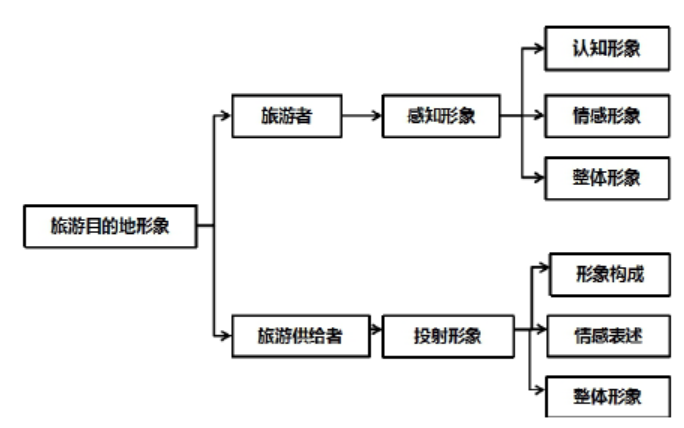基于网络志的黄鹤楼旅游目的地形象分析及提升策略研究毕业论文
2020-02-15 11:18:51
摘 要
当下,旅游市场竞争越来越激烈,在经历了漫长的发展后,如今,旅游市场已经进入了形象驱动阶段,有关地方旅游目的地形象的塑造已经开始成为学术研究的热点。然而,在目前的研究中,绝大多数学者都是从旅游的需求方,也即是游客的角度出发,而忽略了作为旅游的供给方,即对旅游目的地官方机构在旅游供给方面的研究。由于信息传播的双向性,会造成旅游目的地官方机构的投射形象与游客感受到的感知形象存在差异的现象,因此,本文拟以武汉市黄鹤楼景区为研究对象,研究黄鹤楼景区的投射形象与感知形象差异,为黄鹤楼景区的旅游目的地形象提升提供建议。
在研究前期,本文通过八爪鱼采集去哪儿网中游记数据作为感知形象数据来源,并将黄鹤楼公园官网、武汉市旅游委公众号和黄鹤楼景区公众号三个官方机构发布的信息作为投射形象数据的来源,并分别建立感知形象与投射形象的分析类目。之后利用Rost Content Mining软件对网络文本数据进行分析,研究感知形象与投射形象的差异。
网络文本数据分析的结果表明,在旅游宣传物上,感知形象与投射形象内容都反映出黄鹤楼主楼体作为吸引物的绝对地位,但不同之处在于,官方机构正在尝试着将其他主体内容,例如蛇山风景、紫薇园等旅游形象内容传递给游客,然而从目前情况来看,该尝试收效甚微;在旅游伴手礼方面,感知形象与投射形象中均未有突出体现;在旅游活动上,两者都提到了登顶黄鹤楼后的“登高望远”,但不同之处在于,官方机构正在努力宣传其他黄鹤楼旅游活动,例如大师壁画欣赏,诗词歌赋活动等;在情感形象中,官方机构宣传的投射形象与游客的感知形象均为积极向上的,且投射形象的分值略高于游客感知形象分值。
针对数据分析的结果,本文基于文化营销视角与“讲故事”理论提出了减小官方机构的投射形象与游客的感知形象差异的黄鹤楼旅游目的地提升策略。
关键词: 黄鹤楼;感知形象;投射形象;网络志;文化营销;讲故事理论
Abstract
At present, the competition in the tourism market is getting fiercer. After a long period of development, the tourism market has now been in the image-driven stage. The shaping of the images of local tourism destinations has become a hot topic in academic research. However, in the current research, the vast majority of scholars are conducting research from the demand side of tourism, that is, from the perspective of tourists, and neglecting the supply side of tourism, that is, the official institutions of tourism destinations. The two-way nature of information dissemination causes the projected image of the official institution of the tourist destination to differ from the perceived image perceived by the tourists. Therefore, this paper intends to focus on the Yellow Crane Tower scenic spot in Wuhan as the research object and study the difference between its projected image and the perceived image. Finally, suggestions will be provided for the promotion of the destination image of the Yellow Crane Tower.
In the early stage of the study, the paper use the tool of Bazhuayu to collect the information of Qunar website as the source of perceived image data and use the information published by three official agencies, Yellow Crane Tower Park official website, the Wuhan Tourism Commission Wechat official accounts and the Yellow Crane Tower Wechat official accounts as the source of the projected image data. Then separately establishing analytical categories of perceived images and projected images. Then using Rost Content Mining software to analyze the network text data and study the difference between the perceived images and the projected images.
The results of network text data analysis show that in the tourism propaganda, the perceived image and the projected image content reflect the absolute status of the main building of the Yellow Crane Tower as an attraction, but the difference is that the official institutions are trying to transmitte other tourist images, such as the Snake Mountain scenery and the Ziwei Garden to the tourists. However, from the current situation, the attempt has little effect; in the tourism accompanying ceremony, the perceived image and the projected image are not prominently reflected; two both mentioned the “going to the top” when on the summit of the Yellow Crane Tower, but the difference is that the official institutions are working hard to promote other Yellow Crane Tower tourism activities, such as master mural appreciation, poetry song activities, etc.; In the emotional image, the projected image of the official agency propaganda and the perceived image of the tourists are both positive and upward, and the score of the projected image is slightly higher than the score of the perceived image of the visitor.
Based on the results of data analysis, this paper proposes strategies to improve the tourist destination of the Yellow Crane Tower based on the perspective of cultural marketing and the theory of “storytelling” to reduce the difference between the projected image of official institutions and the perceived image of tourists.
Key Words: The Yellow Crane Tower; Perceived image; Projected image; Netnography;
Cultural marketing; Storytelling
目录
摘 要 I
Abstract II
第一章 绪论 1
1.1 研究目的和意义 1
1.1.1 研究目的 1
1.1.2 研究意义 1
1.2 国内外研究现状 2
1.2.1 旅游目的地形象研究现状 2
1.2.2 武汉市旅游营销研究现状 2
1.2.3 网络志研究现状 3
1.3 研究内容和方法 4
1.3.1研究内容 4
1.3.2研究方法 4
1.4技术路线图 5
第二章 理论基础 6
2.1 扎根理论介绍 6
2.2 认知心理学介绍 6
2.3 传播理论介绍 6
第三章 研究设计 8
3.1 数据来源 8
3.1.1 感知形象数据来源 8
3.1.2 投射形象数据来源 9
3.2 感知形象研究设计 9
3.2.1 认知形象分析类目设计 9
3.2.2 情感形象分析类目设计 9
3.2.3 整体形象分析类目设计 10
3.3 投射形象研究设计 10
3.3.1 形象构成分析类目设计 10
3.3.2 情感形象分析类目设计 11
3.3.3 整体形象分析类目设计 11
3.4 感知形象数据处理及分析 11
3.4.1 数据预处理 11
3.4.2 高频词分析 12
3.5 投射形象数据处理及分析 14
第四章 数据分析 16
4.1黄鹤楼旅游感知形象分析 16
4.1.1 认知形象分析 16
4.1.2 情感表达分析 16
4.1.3 整体形象分析 17
4.2 黄鹤楼旅游投射形象分析 17
4.2.1 形象构成分析 17
4.2.2 情感形象分析 17
4.2.3 整体形象分析 18
4.3 形象对比分析 18
第五章 黄鹤楼旅游目的地形象提升策略分析 20
5.1 基于“讲故事”理论的黄鹤楼旅游目的地形象提升策略 20
5.1.1 “讲故事”理论基础 20
5.1.2 通过讲故事塑造品牌形象 21
5.2 文化营销视角的黄鹤楼目的地形象提升策略 21
5.2.1 黄鹤楼景区的文化产品整体概念 22
5.2.2 文化营销过程与策略 22
第六章 结论与展望 24
6.1 结论 24
6.2局限性及未来研究方向 24
6.2.1局限性 24
6.2.2未来研究方向 24
参考文献 25
致 谢 27
第一章 绪论
1.1 研究目的和意义
1.1.1 研究目的
武汉市是我国中部地区最大的城市,也是历史文化名城,它具有非常丰富的人文旅游资源,同时武汉市优越的地理位置与发达的运输条件为武汉市旅游业的发展创造了得天独厚的条件。在近30年间,武汉市的旅游业已经取得了相当程度的发展,形成了以“楚文化”、“现代民主革命”等关键词为核心的旅游布局。然而,从武汉市目前实际旅游地位与旅游形象来看,武汉旅游业的发展状况与其中国中部地区中心地位还不匹合,其在人文旅游资源的潜力发挥方面还有待提高。
在武汉市众多旅游意象中,以“白云黄鹤”为文化代表的黄鹤楼景区成为武汉市旅游目的地最广为人知的旅游形象之一。黄鹤楼景区是我国首批5A级旅游景区,其核心建筑黄鹤楼具有1700多年历史,在历史上享有“天下江山第一楼”的称号,从古代以来,这里就是无数文人墨客抒发感情、吟诗诵文的地点。黄鹤楼景区景观包含有70余处景点,是我国国内最高等级的旅游品牌,然而,从黄鹤楼公园景区发布的旅游收入数据来看,其门票收入占据绝大部分收入,由此可见其收入结构来源单一。同时,根据黄鹤楼景区在2009年及之后发布的收入数据显示:除因2009年的门票价格上涨带来了当年的景区利润升高后,之后黄鹤楼景区的收入一直保持稳定状态,其景区发展活力明显停滞。而在2018年,国家发展改革委发布的《关于完善国有景区门票价格形成机制 降低重点国有景区门票价格的指导意见》指出要降低国有景区门票价格,要将旅游业从门票经济向产业经济方向发展[1]。在此背景下,黄鹤楼景区势必要改变其传统的门票经济模式,要通过挖掘上千年历史的名楼文化内涵,改变传统的游客简单观光方式,逐步走向高端文化休闲景区。
而在这一过过程中,如何建立新的黄鹤楼景区形象便显得尤为重要,因此本文拟采用旅游目的地的相关理论,探讨其旅游需求与旅游供给两个部分的内容,分别从黄鹤楼景区的感知形象与投射形象两个角度出发,探讨旅游的需求方建立的感知形象与旅游的供给方宣传的投射形象的匹配问题,然后结合其差异性分析产生差异的原因,得出相应的结论,最终为黄鹤楼旅游目的地形象提升提供相应的建议与意见。
1.1.2 研究意义
本文的理论意义在于弥补旅游目的地形象研究中过分关注感知形象的不足,同时使用网络志的研究方法而非传统问卷调查的方法提高了数据来源的真实性、可靠性与客观性,充分利用大数据时代网络数据资源。本文的实际意义在于基于网络志分析研究结果,为黄鹤楼景区提供旅游目的地形象提升建议,充分挖掘文化内涵与发挥其文化特点,结合互联网大数据时代营销策略,为景区经济策略转型提供建议。
1.2 国内外研究现状
1.2.1 旅游目的地形象研究现状
目前,有关“旅游目的地形象”的概念尚且没有定论,有些学者也将其称之为“旅游形象”、“游客形象”或“目的地形象”。美国科罗拉多州立大学Hunt,J.D学者在1975 年提出了旅游目的地形象的概念[2],随后,学者们则在此基础上将旅游目的地形象分成了投射形象和感知形象,中间的感知形象是指游客对旅游目的地持有的认知态度[3],这一形象是由旅游提供者投射得到的形象与旅游者个人特质相互影响后得到的,它们是由旅游者在大脑中生成的旅游地点形象。而投射形象是指旅游形象供给方通过多种多样的方式传递给游客的形象。
 关于感知形象,在1999年,Balogu提出其研究内容包含有三个层次:认知形象、情感形象与整体形象[3]。关于投射形象,1991年,Barich与Kolter提出,从旅游营销的角度来看,其构成包含有“投射形象”、“接受形象”[4]。而在2015年,Pike S以供需双视角给旅游目的地形象开展划分,对“感知形象”与“投射形象”加以了深入的讨论[5]。通过上述文献,本文从来源于旅游者的“感知形象”与旅游提供者展示的“投射形象”两方面构成旅游目的地形象,其中,感知形象是由认知形象、情感形象和整体形象三个维度组成,而投射形象是由形象构成、情感表达与整体形象三方面组成,最终上述六个角度分别从供给方与提供方构成了旅游目的地形象的构建,如图1.1所示。
关于感知形象,在1999年,Balogu提出其研究内容包含有三个层次:认知形象、情感形象与整体形象[3]。关于投射形象,1991年,Barich与Kolter提出,从旅游营销的角度来看,其构成包含有“投射形象”、“接受形象”[4]。而在2015年,Pike S以供需双视角给旅游目的地形象开展划分,对“感知形象”与“投射形象”加以了深入的讨论[5]。通过上述文献,本文从来源于旅游者的“感知形象”与旅游提供者展示的“投射形象”两方面构成旅游目的地形象,其中,感知形象是由认知形象、情感形象和整体形象三个维度组成,而投射形象是由形象构成、情感表达与整体形象三方面组成,最终上述六个角度分别从供给方与提供方构成了旅游目的地形象的构建,如图1.1所示。
图1.1 旅游目的地形象供给关系




